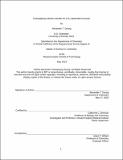| dc.contributor.advisor | Drennan, Catherine L. | |
| dc.contributor.author | Duong, Alexander T. | |
| dc.date.accessioned | 2024-12-02T21:15:38Z | |
| dc.date.available | 2024-12-02T21:15:38Z | |
| dc.date.issued | 2024-05 | |
| dc.date.submitted | 2024-11-18T19:27:23.653Z | |
| dc.identifier.uri | https://hdl.handle.net/1721.1/157731 | |
| dc.description.abstract | The metallocofactors utilized by enzymes can range in complexity from single metal ions to organometallic cofactors well over 1000 Da. These cofactors enable these metalloenzymes to accomplish a diverse set of unique and challenging chemistry that are critical to core life functions. One of these metallocofactors, adenosylcobalamin (AdoCbl), has only one cognate enzyme in humans: methylmalonyl-CoA mutase (MCM), which is involved in the catabolism of several amino acids, cholesterol, and odd-chain fatty acids. MCM relies on two other proteins, a G-protein metallochaperone called methylmalonic aciduria type A protein (MMAA) and a protein called adenosyltransferase (ATR), to load and off-load cofactor. Mutations or deletions of the gene for MCM, or in any of the genes corresponding to accessory proteins which interfere with cofactor delivery and removal, can lead to a potentially lethal inborn error in metabolism. If the cofactor becomes damaged in the active site of MCM, ATR unloads the cofactor, repairs it, and reloads the regenerated AdoCbl onto the mutase. A molecular understanding of this process has been challenging to obtain due to the difficulty of structurally characterizing a three-protein MCM-MMAA-ATR complex that is transient in nature. An orthologous protein from C. metallidurans in which the G-protein metallochaperone is naturally fused to its target mutase isobutyryl-CoA mutase (IcmF) provides an alternative two-protein IcmF-ATR system for structural and biochemical characterization. Recent work has shown that the IcmF system utilizes a mechanism of active site opening similar to non-fused systems like that of humans. However, the mechanisms by which ATR recognizes the presence of damaged cofactor and then removes it remains unclear. In this thesis, we discuss the development of an assay based on UV-Vis spectroscopy to monitor cofactor transfer between IcmF and ATR. We also discuss efforts to substitute histidine residues in IcmF suspected of serving as intermediate binding sites during cofactor transfer, with the goal of using the developed assay as a means of observing potential changes in transfer efficiency by perturbing these histidine residues. This work seeks to improve our understanding of AdoCbl-dependent enzyme maturation, and inform our ability to harness their unique reactivity. | |
| dc.publisher | Massachusetts Institute of Technology | |
| dc.rights | In Copyright - Educational Use Permitted | |
| dc.rights | Copyright retained by author(s) | |
| dc.rights.uri | https://rightsstatements.org/page/InC-EDU/1.0/ | |
| dc.title | Investigating cofactor transfer for a B₁₂-dependent enzyme | |
| dc.type | Thesis | |
| dc.description.degree | S.M. | |
| dc.contributor.department | Massachusetts Institute of Technology. Department of Chemistry | |
| dc.identifier.orcid | https://orcid.org/0000-0002-0884-668X | |
| mit.thesis.degree | Master | |
| thesis.degree.name | Master of Science in Chemistry | |
